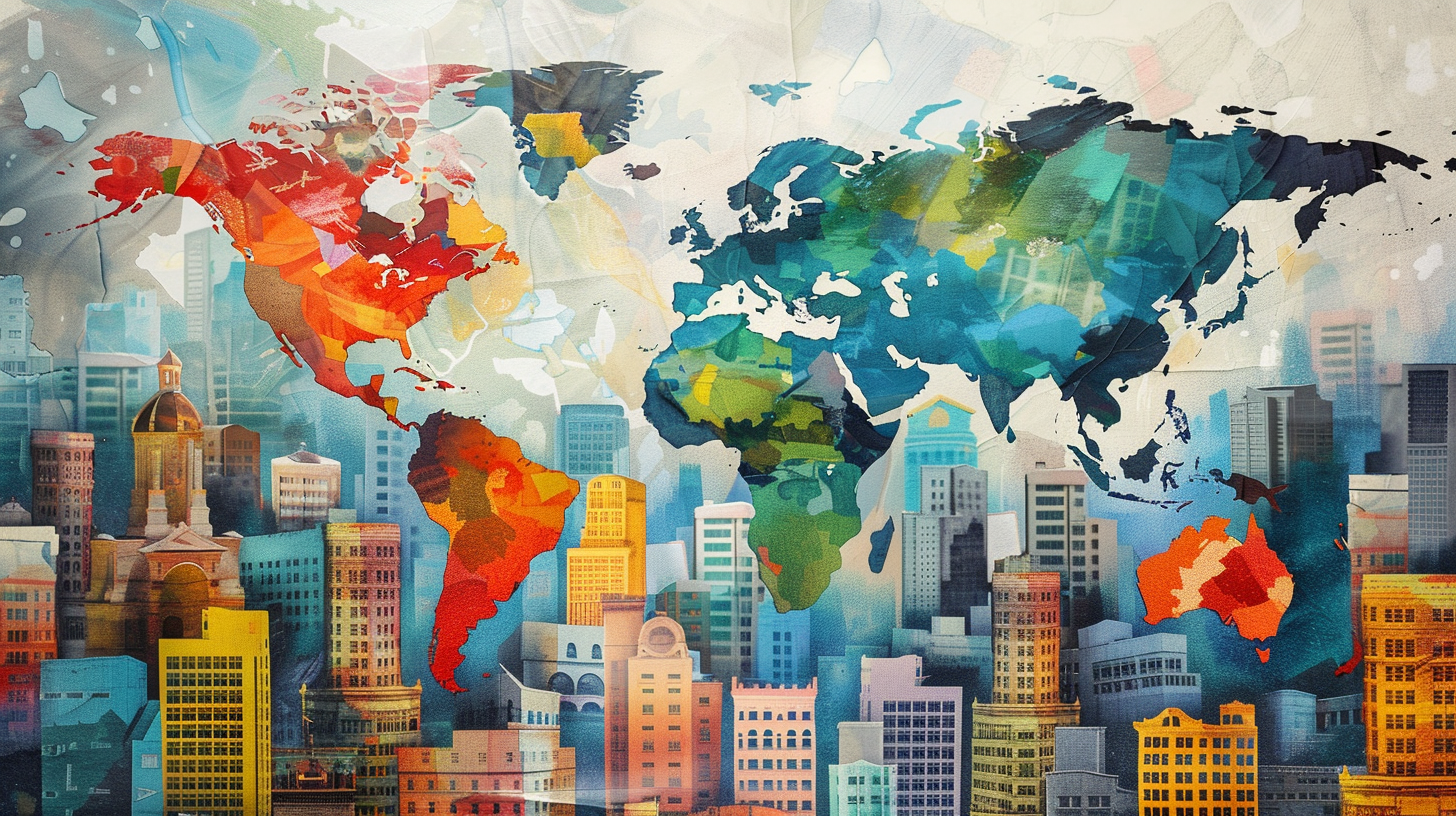Table of Contents Show
In our rapidly shrinking world, cultures are meeting in the gently labeled ‘melting pot’ of globalization. We’re witnessing an unprecedented exchange of traditions, languages, and ideas, reshaping the tapestry of cultural identities. This evolution raises questions about the future of our cultural heritage and the very essence of individuality within the global community. How do these interactions influence who we are and how we see others? Let’s explore the delicate balance between embracing a global identity and preserving the unique characteristics that define us, inviting you to ponder the profound implications these exchanges have on our collective human experience.
Key Takeaways
- Globalization enriches cultural identities through exposure to diverse cultures and ideas.
- Cross-cultural collaborations foster innovative solutions and a unified global community.
- Technology enhances cross-cultural interaction, making global cultures accessible to all.
- Language and communication evolve, reflecting the intertwined nature of our global society.
Understanding Globalization
Fundamentally, globalization is the process through which the world’s economies, cultures, and populations become more interconnected and interdependent. It’s a force that’s reshaping our world, challenging us to adapt, and offering us the freedom to engage with diverse cultures and ideas. We’re living at a time where information, goods, and services flow across borders with unprecedented ease. This connectivity isn’t just about economics; it’s about the exchange of ideas, the blending of cultures, and the creation of a global community.
We’ve seen how the digital revolution has played a pivotal role in accelerating globalization. The internet has broken down barriers, making it easier for us to access information, communicate, and collaborate with people from different parts of the globe. We’re no longer confined to our local environments; we’re part of a vast, dynamic network. This newfound freedom has empowered us to learn from each other, to grow, and to challenge the status quo.
However, embracing globalization doesn’t mean losing our cultural identities. Instead, it’s an opportunity to share our unique traditions and values with the world, while also appreciating the richness of other cultures. We’re not just passive participants; we’re active contributors to this global exchange. We have the power to shape how globalization evolves, ensuring it reflects our collective desire for freedom, understanding, and mutual respect.
Fundamentally, globalization offers us a path to a more interconnected and harmonious world. It’s up to us to navigate this path wisely, leveraging the opportunities it presents to foster a global community that celebrates diversity and freedom.
The History of Cross-Cultural Exchanges
Throughout history, we’ve witnessed an intricate web of cross-cultural exchanges, shaping civilizations by blending ideas, traditions, and innovations from across the globe. These exchanges have been pivotal in fostering understanding, cooperation, and growth among diverse societies. They’ve allowed us to break free from the confines of our local worlds, exploring and embracing the richness of global cultures.
-
The Silk Road Era: One of the earliest and most significant examples of cross-cultural exchange was the Silk Road, which connected Asia, Africa, and Europe. This network wasn’t just about trading silk; it was a conduit for the exchange of philosophies, religions, technological innovations, and even cuisines. It showed us that our thirst for exploration and connection could overcome vast distances and challenges.
-
The Age of Discovery: The Age of Discovery, starting in the 15th century, marked another pivotal period. European explorers set sail across oceans, driven by the desire for new trade routes and territories but ended up connecting the world in ways previously unimaginable. This era introduced us to the concept of a global community, albeit through the lens of colonialism, which we continue to grapple with and learn from today.
-
Cultural Fusions: Throughout the ages, we’ve seen the emergence of culturally fused practices, languages, and art forms, from the spread of Islam across continents to the global influence of American jazz music. These fusions have enriched our societies, offering new ways of expressing our shared humanity.
The Role of Technology
Building on our understanding of historical cross-cultural exchanges, we now explore how technology amplifies and reshapes these interactions in the modern world. In today’s landscape, we’re witnessing an unprecedented level of interconnectivity, largely fueled by advancements in technology. This digital revolution has given us tools that not only bridge vast distances but also bring diverse cultures into closer dialogue than ever before.
We’ve seen the internet open doors to global markets, social media platforms facilitate instant communication across continents, and streaming services make cultural products accessible worldwide. These technological innovations have greatly altered the way we experience and participate in cross-cultural exchanges.
Here’s a quick overview of technology’s role in this dynamic:
| Technology Type | Impact on Cross-Cultural Exchange | Example |
|---|---|---|
| Internet | Broadens access to information | Online forums |
| Social Media | Facilitates real-time communication | |
| Streaming Services | Makes global entertainment accessible | Netflix |
| E-commerce | Enables global marketplaces | Amazon |
| Translation Software | Overcomes language barriers | Google Translate |
These tools haven’t just expanded our horizons; they’ve empowered us to navigate global cultures with greatly increased freedom. We’re now participants in a world where cultural boundaries are increasingly blurred, not by the eradication of difference, but through the celebration and exchange of our diverse identities. As we harness these technologies, we’re crafting a global narrative that values freedom, understanding, and connectivity.
In embracing this digital era, we’re not just observers of cultural exchange; we’re active creators in a rapidly evolving global mosaic. The technology at our fingertips is the brush with which we paint our collective future, transcending geographical and cultural barriers to forge a world that cherishes freedom and diversity.
Cultural Identity in a Globalized World
As we navigate the complexities of globalization, our cultural identities are both challenged and enriched by this interconnected world. The fusion of global cultures has provided us with a broader perspective, offering an opportunity to explore and integrate diverse traditions, beliefs, and practices. In this journey, we’ve discovered that the preservation of our unique cultural identities within the global tapestry is not just crucial but also empowering.
Globalization has undeniably blurred the lines of cultural boundaries, but it has also presented us with a unique set of opportunities:
-
Exposure to Diverse Cultures: We’re no longer confined to the cultural experiences within our immediate surroundings. Global connectivity allows us to experience the world from the comfort of our homes, encouraging a deeper understanding and appreciation for the diversity that exists beyond our local communities.
-
Cultural Exchange and Collaboration: The ease of global communication and travel fosters cross-cultural collaborations that were once unthinkable. These collaborations often result in innovative solutions to global issues, showcasing the strength that lies in our diversity.
-
Empowerment through Choice: With the world at our fingertips, we’re empowered to choose which cultural elements resonate with us the most. This freedom to choose strengthens our cultural identities, as we’re not just passive recipients of cultural influences but active participants in shaping our cultural landscapes.
In embracing the freedoms afforded by globalization, we’re crafting a global community that values diversity and unity in equal measure. Our cultural identities, enriched by global influences, stand as a tribute to our collective resilience and adaptability in the face of change.
The Impact on Language
As we explore the impact of globalization on language, we’ll find that language blending, new linguistic hierarchies, and the influence of the digital era are key phenomena reshaping how we communicate. Each of these aspects contributes to a dynamic evolution in the way languages are used and perceived globally. We’ll examine how these changes challenge traditional linguistic identities and foster a more interconnected global culture.
Language Blending Phenomena
We’re witnessing an unprecedented blending of languages worldwide, reshaping how we communicate and understand each other. This fusion is not just about borrowing words; it’s about merging identities and creating new ways of expression that transcend traditional boundaries. Here’s how it’s unfolding:
- Spanglish, Hinglish, and Chinglish are becoming more prevalent, reflecting the intertwined lives of people who straddle two cultures.
- Art and music are rich fields where language blending thrives, allowing artists to reach wider audiences by mixing linguistic elements.
- Social media and digital platforms accelerate this blending, enabling instant global communication and the viral spread of mixed-language content.
In embracing this phenomenon, we’re not just expanding our vocabularies; we’re embracing a global identity that celebrates the freedom to communicate beyond borders.
New Linguistic Hierarchies
Building on the blending of languages, it’s important to explore how this phenomenon is reshaping linguistic hierarchies worldwide. We’re witnessing a shift where once-dominant languages are sharing space with emerging tongues, reflecting a more inclusive global culture. This change champions the idea that every language holds value, challenging the traditional power dynamics that favored a select few. It’s a move towards linguistic democracy, where the voices of minority and indigenous communities gain recognition and space.
We’re part of a generation that’s redefining what it means to communicate across cultures. By embracing a multitude of languages, we’re not just breaking down barriers; we’re building bridges. This isn’t about losing our linguistic roots but enriching them, ensuring that our global conversations are more diverse, inclusive, and vibrant than ever.
Digital Era Influence
The digital era has revolutionized the way we use and perceive languages, breaking down traditional barriers and fostering a global exchange of words and ideas. We’ve witnessed firsthand how technology shapes our communication, offering us freedom to express and connect in ways unimaginable before. Here’s how:
- Social Media Platforms: They’ve become melting pots of linguistic diversity, encouraging us to learn and adopt phrases from different cultures.
- Translation Tools: Instantly breaking the language barrier, these tools empower us to explore and understand far-reaching corners of the globe.
- Online Learning: It’s now easier than ever to learn new languages, fostering a deeper appreciation for the nuances that define cultural identities.
In embracing these changes, we’re not just adapting; we’re actively participating in a linguistic revolution that celebrates freedom and connection.
Globalization and Cuisine
Exploring how globalization has reshaped local cuisines, we find that traditional dishes are now blending with international flavors, creating an exciting culinary mosaic around the world. This fusion not only introduces us to new tastes but also brings us closer, allowing us to celebrate our shared love for food. It’s like we’re on a constant journey, discovering meals that tell the story of cultural convergence without ever having to leave our dinner tables.
As we embrace these culinary crossroads, we’re not just expanding our palates; we’re breaking down barriers. The rise of international food markets and restaurants in every corner of the globe means we can savor authentic Japanese sushi in the heart of New York City or enjoy hearty Italian pasta in Tokyo. This accessibility fosters a sense of freedom, urging us to explore beyond our culinary comfort zones and immerse ourselves in the unknown.
The internet plays a pivotal role in this global food revolution. We’re now a click away from recipes that span continents, enabling us to experiment with exotic ingredients and cooking techniques in our own kitchens. It’s empowering to realize that we can recreate the world’s cuisine at home, blending the traditional with the new to craft dishes that reflect our individual tastes yet celebrate global heritage.
Globalization has transformed our kitchens into melting pots of cultural exchange. We’re no longer confined by geographical boundaries when it comes to what we eat. Instead, we’re free to curate our menus from the vast array of global cuisines, making every meal an adventure and every bite a story of cultural harmony.
Music Across Borders
Just as culinary traditions have traversed continents, music too crosses borders, uniting us in a universal language that knows no boundaries. This occurrence not only enriches our cultural experiences but also fosters a sense of freedom and connection among us. We’re living in an era where music from the furthest corners of the globe can be accessed with a simple tap on a screen, blending the traditional with the contemporary in ways we’ve never seen before.
Music’s journey across borders can be seen in:
-
The Rise of World Music: Artists from various countries are now household names worldwide, thanks to their unique blends of local sounds with universally appealing rhythms. This has created a global platform for genres that were once confined to specific regions.
-
Collaborative Projects: We’re seeing an increasing number of collaborations between artists from different countries, creating a fusion of sounds that transcends cultural barriers. These partnerships not only produce enthralling music but also spread messages of unity and peace.
-
Live Performances and Festivals: Music festivals around the world often feature artists from a multitude of backgrounds, drawing crowds that are just as diverse. These events are celebrations of the freedom to express and experience the world’s cultural richness through music.
We find ourselves in a beautifully interconnected world where music acts as a bridge, connecting us across cultural divides. It’s a sign of humanity’s shared experiences and emotions, proving that, despite our differences, we can find common ground and harmony in the melodies that move us.
Fashion and Global Trends
Much like music, fashion trends have also gone global, reshaping our wardrobes and cultural identities in the process. We’ve embraced styles from across the globe, blending them with our local fashion sense to create something uniquely our own. It’s a vibrant expression of freedom, allowing us to communicate who we are and where we come from, all while exploring new horizons.
The table below showcases how global trends have influenced various aspects of fashion:
| Global Trend | Local Impact |
|---|---|
| Streetwear from Tokyo | Inspired urban youth worldwide, leading to a surge in oversized and bold print clothing. |
| Scandinavian minimalism | Brought a clean, understated look to our closets, emphasizing quality and sustainability. |
| South Korean beauty standards | Popularized skincare routines and fashion choices that highlight youthfulness and innovation. |
| British punk culture | Reinforced the idea of fashion as a form of rebellion, introducing leather jackets and ripped jeans into mainstream. |
| Indian textiles | Infused wardrobes with vibrant colors and patterns, celebrating traditional craftsmanship in a modern context. |
We’re not just adopting these trends; we’re adapting them. It’s not about losing our identity but enriching it, finding new ways to express our individuality and cultural heritage. This exchange isn’t one-way; it’s reciprocal, with our local innovations also finding a place on the global stage.
It’s clear that in our quest for freedom, fashion serves as a canvas. We’re painting a picture of a world where boundaries are blurred, and creativity knows no limits. Through our clothes, we’re not just making a statement; we’re inviting conversation, encouraging a deeper understanding and appreciation of the diverse world we share.
Preserving Cultural Heritage
As we turn our attention to preserving cultural heritage, it’s essential that we consider the protection of heritage sites and the role of digital archiving initiatives. These approaches offer concrete steps in safeguarding the physical and digital footprints of our cultures. By doing so, we guarantee that future generations can connect with and appreciate our diverse cultural identities.
Heritage Sites Protection
Why should we prioritize the protection of heritage sites in our efforts to preserve cultural identity? In an age where freedom defines our quest for identity, safeguarding these sites isn’t just about preservation; it’s about asserting our rights to remember and celebrate our collective past.
- Cultural Continuity: They anchor us to our history, providing a sense of continuity and belonging in a rapidly changing world.
- Educational Value: These sites offer invaluable lessons on human creativity, resilience, and the complexity of our societies.
- Economic Benefits: Beyond their historical significance, heritage sites attract tourism, creating jobs and fostering community pride.
Let’s champion the protection of heritage sites, not as relics of the past, but as beacons for our future.
Digital Archiving Initiatives
Embracing digital archiving initiatives offers us a powerful tool in preserving cultural heritage for future generations. By digitizing artifacts, manuscripts, and traditional practices, we’re not just safeguarding our history; we’re ensuring that our stories remain accessible in the face of globalization’s rapid changes. This approach allows us to break free from geographical and temporal constraints, enabling a worldwide audience to experience and engage with diverse cultures. We’re also empowering communities by giving them control over how their cultural expressions are shared and perceived globally. Through digital archives, we’re fighting against the erosion of identity and promoting a more inclusive understanding of heritage. It’s a way for us to stand our ground, showcasing the richness of our cultures while fostering a sense of global unity and respect.
Challenges of Cultural Homogenization
The growing trend of cultural homogenization poses significant challenges to the preservation of diverse cultural identities around the globe. As we navigate through the waves of globalization, recognizing how crucial it is to acknowledge how it can sometimes dilute the rich tapestry of human culture. We’re at a crossroads, where the balance between embracing a global community and maintaining our unique cultural heritages hangs in the balance.
Here are three critical challenges we face:
-
Loss of Cultural Diversity: As global cultures intermingle, there’s a risk that unique traditions, languages, and practices may fade into obscurity. Recognizing that losing recipes or folk tales is not just a concern; it’s about losing pieces of human history and wisdom that have been passed down through generations.
-
Dominance of a Single Culture: Often, cultural homogenization leans heavily towards the spread of Western culture. This dominance can overshadow and even suppress local cultures and traditions, leading to a world where diversity is narrowed down to variations on a singular theme rather than a mosaic of different cultures.
-
Erosion of Cultural Identity: For many, cultural traditions form a core part of their identity. As these traditions get diluted or replaced, individuals may feel a loss of connection to their ancestry and heritage. This disconnection can lead to a sense of rootlessness and a longing for a sense of belonging that seems increasingly elusive.
We must champion the cause of cultural preservation, ensuring that globalization becomes a force for sharing and learning, rather than an engine of homogenization. Let’s celebrate our differences and promote a world where every culture has the freedom to thrive and contribute to our collective human experience.
The Economic Aspect of Cultural Exchange
We’re now shifting our focus to explore how economic dynamics shape cultural exchanges worldwide. We’ll examine how trade influences cultures, the role of cultural products in markets, and how economic policies can either support or hinder cultural diversity. This analysis aims to uncover the intricate ways in which the global economy and cultural identities interact.
Trade’s Influence on Culture
Trade profoundly shapes our cultural landscapes, intertwining economies with local customs and practices. It’s not just about the exchange of goods; it’s a transfer of values, ideas, and traditions that enrich our global community. We see this influence through several key aspects:
- Cuisine Evolution: Diverse foods and ingredients become accessible worldwide, allowing us to taste and embrace different cultures right at our dinner tables.
- Artistic Inspiration: Artists across the globe draw upon a wider palette of influences, leading to innovative and hybrid forms of expression.
- Knowledge Exchange: Educational materials and philosophies cross borders, fostering a more interconnected and informed world populace.
In embracing trade’s role in our lives, we’re not just advocating for economic benefits but for a more vibrant, diverse, and free world.
Cultural Products in Markets
Exploring the economic aspect of cultural exchange, cultural products in markets reveal a fascinating dynamic between creativity and commerce. We’re witnessing how these items, ranging from art, music, to cuisines, serve as bridges between diverse cultures. They’re not just commodities; they’re messengers of our cultural identities. As we embrace them, we’re also supporting the artists and creators behind them, fueling a vibrant global marketplace. It’s a domain where cultural appreciation and economic benefit intertwine, offering us a taste of freedom. We get to explore and connect with different cultures on our own terms, discovering the wealth of diversity this world has to offer. These exchanges enrich us, broadening our horizons and fostering a deeper understanding and respect for the myriad ways of life that populate our planet.
Economic Policies and Diversity
As globalization accelerates, economic policies play a pivotal role in shaping the diversity of cultural exchanges. We’re witnessing a remarkable transformation where cultures intertwine, creating a vibrant tapestry of global identity. This change isn’t coincidental; it’s driven by deliberate economic strategies that prioritize openness and connectivity. Here’s how:
- Trade Agreements: These pacts reduce barriers, allowing goods, services, and, significantly, cultural products to flow freely across borders.
- Investment in Cultural Industries: Governments and private sectors investing in cultural sectors boost local traditions and enable them to go global.
- Digital Platforms: Policies that support digital infrastructure make it easier for cultures to share their narratives worldwide, enriching the global cultural landscape.
Through these strategies, we’re not just sharing economies; we’re sharing parts of ourselves, fostering a world that values freedom and diversity.
Globalization and Religion
Globalization has significantly reshaped how we comprehend and practice religion across the world. It’s flung open the doors to a vast array of beliefs and practices, allowing us to explore and integrate diverse spiritual perspectives. We’re no longer confined to the religious traditions of our immediate community or heritage. Instead, we’ve gained the freedom to seek out and adopt beliefs that resonate with us on a personal level, often blending elements from multiple traditions to create a unique spiritual identity.
This global exchange has also sparked dialogues that were once unimaginable, fostering a deeper understanding and respect among different faiths. We’re learning from each other, borrowing practices that enrich our spiritual lives, and in the process, we’re knitting a more interconnected global community. It’s a dynamic, ongoing exchange that challenges us to think critically about our beliefs and the role they play in our lives and the wider world.
However, this freedom comes with its challenges. The sheer diversity of beliefs can sometimes feel overwhelming, making it difficult to find our spiritual footing. Additionally, the rapid spread of information means that religious ideas and practices are constantly evolving, requiring us to stay open and adaptable.
Despite these challenges, we embrace the opportunities globalization presents. It empowers us to craft a religious identity that’s truly our own, one that reflects our individual values and experiences. In doing so, we’re not just passive participants in our spiritual journeys; we’re active creators, shaping our beliefs to reflect our quest for meaning in an interconnected world.
Embracing Diversity, Fostering Unity
In today’s world, we’re finding that embracing our diverse cultural backgrounds is key to fostering a sense of unity among us. As we navigate through the complexities of globalization, it’s becoming increasingly clear that our differences don’t have to divide us. Instead, they can be the very thing that unites us, strengthening our communities and enriching our lives in unimaginable ways.
Here’s how we can make it happen:
-
Celebrate Cultural Festivals Together: Participating in each other’s cultural celebrations isn’t just fun; it’s a profound way to understand and appreciate the richness of our diverse world. By sharing our traditions, we’re fundamentally saying, ‘I see you, I respect you, and I’m willing to learn from you.’
-
Promote Inclusive Dialogue: We must create spaces where everyone feels safe to express their cultural identities and perspectives. These dialogues, rooted in respect and curiosity, are the bedrock of mutual understanding and unity. It’s through conversation that we discover our shared humanity.
-
Support Cross-Cultural Collaborations: Whether it’s in the arts, sciences, or business, collaborative projects that cross cultural lines inspire innovation and foster a sense of global community. By working together, we’re not just achieving our goals; we’re weaving a tapestry of interconnectedness that celebrates our differences.
Embracing diversity and fostering unity isn’t just about coexisting; it’s about thriving together in a world that values freedom, respects individuality, and recognizes that our collective strength lies in our diversity. Let’s commit to breaking down barriers and building bridges, for in our unity, we find our freedom.
Conclusion
We’ve explored how globalization reshapes our cultural identities, emphasizing the richness it brings and the challenges it poses. Amidst this, one statistic stands out: over 7,000 languages are spoken worldwide today, yet a language dies every two weeks. This loss is a stark reminder of what’s at stake. As we navigate this global landscape, let’s cherish and preserve our diverse cultures. By doing so, we not only celebrate our differences but also strengthen our collective human spirit.







